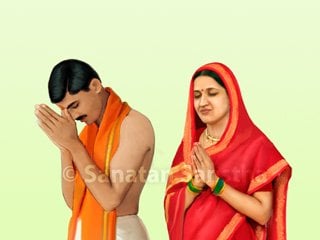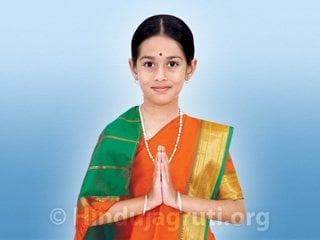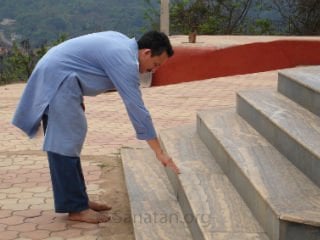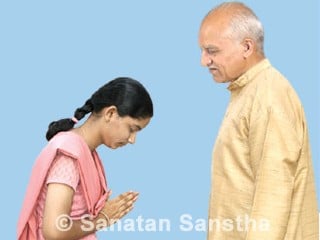Marriage means blending of Principles of Deity Shiva in the form of husband and Shakti in the form of wife. Every act is taken to its completion jointly by performing that act through the sagun (Materialised) kriya-shakti (Energy of action) in the form of Deity Shiva and giving further momentum to that act through the nirgun (Non-materialised) Shakti. After marriage, both jivas enter the householder stage. It is very important to obtain blessings of the elders jointly to perform various activities in life in the householder stage by complementing each other. Paying obeisance together, leads to activation of waves of Deity Shiva and Shakti from the Universe. This starts developing humility in the jiva. It results in fulfillment of every deed in the householder stage and yields desired fruit from it, leading to possibility of minimum give and take. That is why, after marriage, a couple is required to perform every act together and should comply with each other even in an act like paying obeisance. This is the only aim underlying the act stated above.
1. When husband and wife are paying obeisance
together, on which side of her husband should the wife stand ?

While performing any act, the wife should stand to the right of her husband. The wife is considered as better half of the husband, that is, Suryanadi. The Suryanadi is symbolic of the manifest functional Shakti of the Adishakti (Primal Energy), which is the provider of energy for every act. The Chandranadi, indicative of the God Principle, is symbolic of Shiva who actually functions on the strength of the energy provided by the Adishakti. As a Shakti of Deity Shiva, the wife is to stand to the right of her husband and support him in every action. In every ritual, the wife without performing any actual act, provides him with the karya-urja of Sri Durgadevi required for the ritual by touching four fingers of her right hand to his right arm. That is why, the act performed by the host and his wife bear fruit in a shorter period due to assistance from Shiva-Shakti.
2. How should a married couple pay
obeisance to someone other than a Deity ?
A. Paying obeisance to a Saint or Guru
A married couple should bow their heads together at the Holy feet of a Saint or Guru in such a way that their mid-brow region touches His big toe. The wife should touch her mid-brow region to His right big toe, while the husband should touch his mid-brow region to His left big toe.
Vibrations of Shakti are emitted in vast proportions by the big toes of any Saint or Guru; hence, when both, the husband and the wife pay obeisance to the Saint or Guru together by touching their heads to His feet, it becomes a complete obeisance and the couple gets maximum benefit of the Shakti of the Saint or Guru. If the husband and wife pay obeisance separately, only one big toe is touched at a time by their mid-brow region. Thus, the couple is deprived of the benefit of paying obeisance together.
B. Paying obeisance to a Brahman
Obeisance to a Brahman should be paid in the same manner as paid to a Saint or Guru.
Since the blessings bestowed by a Deity are meant for the couple, obeisance paid together by a couple by touching their heads to the feet of the Brahman (who blesses them according to the guidance of the Deity) reaches the Deity of worship and the couple together benefit from the blessings of the Deity.
3. While paying obeisance to elders, why should
a married woman move her hand up and down thrice ?
A married woman symbolises the hidden energy of unmanifest Adimaya at the nirgun level. She is the sagun form of Adishakti which accomplishes advait (Non-duality) from Maya (Great Illusion). When we perform any action thrice or pronounce anything thrice, at that moment God’s resolve becomes effective at the three levels of Ichha (Will), Kriya (Action) and Dnyan (Knowledge). This results in completion of the task undertaken. A married woman has seeds of Adimaya and Adishakti in a dormant state. When she bows and moves her hand thrice, due to speedy Raja waves that get activated by this act and also due to manifestation of the bhav (Spiritual emotion) of humility from her, the God Principle in the elderly individual gets activated. This God Principle provides her with manifest energy to perform any task. This energy in turn activates her Atmashakti (Energy of the soul). This energy provides momentum to her kriyaman (Wilful action) and on the strength of Adimaya, she emancipates her family too. Since her husband too receives the benefit of Raja waves of Chaitanya (Divine consciousness) emitting from her, he too can work actually in the form of Deity Shiva amidst Maya.

 What should be done and what should be avoided while paying obeisance ?
What should be done and what should be avoided while paying obeisance ? Methods of paying obeisance
Methods of paying obeisance Paying obeisance – A simple act of expression of Divine qualities that bestows Divine Energy
Paying obeisance – A simple act of expression of Divine qualities that bestows Divine Energy Why ‘Namaskar’ and not a ‘hand shake’?
Why ‘Namaskar’ and not a ‘hand shake’?